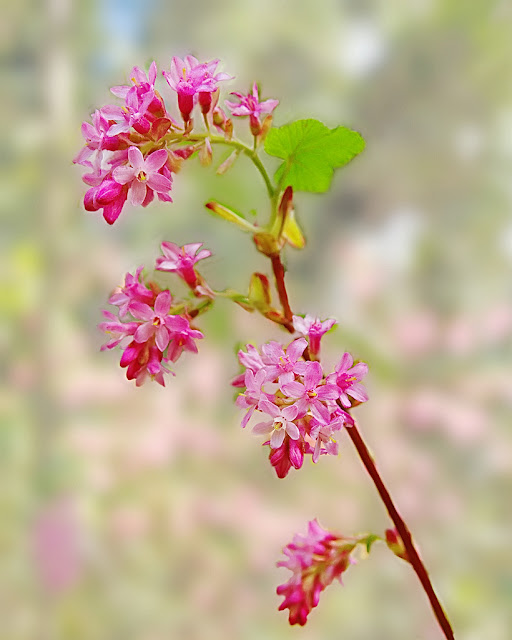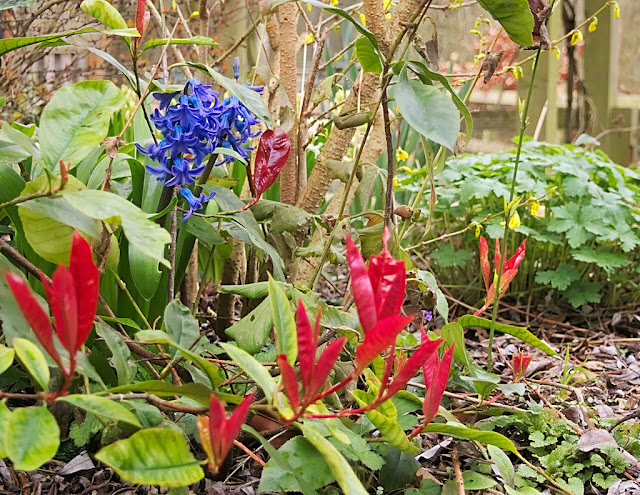One of the pleasures of writing this blog has been learning about the plants that I have photographed. It has not been the botannical science that has piqued my interest so much as the folk lore and herbal remedies associated with the trees and flowers. For it is the plant lore, and the origins of some of the romantic sounding vernacular names, that give such a fascinating insight into way our predecessors viewed the world.
 |
| Blackthorn Blossom - 26 March 2017 Superficially very similar to the plum blossom, but without any leaves and the individual blossom are slightly smaller. |
Previously, in this blog, I have discussed how the name we use for a plant or flower alters our perception of it ( see my post 'Using New Eyes Part 3' ). I believe that the same is true of anything that we have learnt or have been told about something. So after reading about the old superstitions surrounding some particular species, we can never look at it in quite the same way again; we see it in a new light.
One bush that I will now look at somewhat differently is the blackthorn, a shrub that is easily overlooked in Milton Country Park as its white flowers appear just as the very similar cherry plum blossom is dying off. It is very easy to confuse the two species, as I did in 2015 when I misidentified all the early white cherry plum blossom as blackthorn. In fact, there are only half a dozen or so blackthorn bushes in the park.
The name 'blackthorn' is not a great revelation: it is simply a straightforward description of the bush, and suggests the means of distinguishing it from the cherry plum, which does not have thorns.
What has changed the way that I look at blackthorn is learning that it is the preferred wood for making shillelaghs. Apparently, wood from the blackthorn root is particularly suitable as it does not crack during use. Shillelaghs were originally clubs used for fighting and self defence, and are still used in a form of martial art. Now, whenever I see a blackthorn bush, I will inevitably think of it as the source of that most potent symbol of Ireland.
Beyond its Irish connection, and its use in making sloe gin, blackthorn has gained a sinister reputation over the thousands of years it has been
known to man. It has been very
heavily associated with witches and the dark side of their craft.
Its wood was used to make a wand with thorns at its end used to cast spells to bring harm
to others. The tree is also linked to warfare and death.
This is my third post in a series on the subject of March flowers in the park. The first two in the series dealt with plum blossom and with daffodils. Besides these and the blackthorn, there were a few isolated bushes in flower, a couple of which caught my eye.
The first was a large berberis bush on the banks of Dickerson's Pit. It had clearly been established for a number of years, yet I had completely missed seeing it up until now. Though I am disappointed in my failure to spot the bush, in many ways, it is a very good illustration of the underlying philosophy of this whole project: there is a lot to gained by close careful observation of our environment, however familiar it may be.
Then there are a number of flowering current bushes scattered around the park. Their pink flowers providing a contrast to the prevailing whites and yellows of the other blossom in the park.
There was more colour in the sensory garden, which is at its prettiest in early spring. But without any large blocks of colour, the interest was in the detail, like the contrast between this blue hyacinth and the red leaves surrounding it.
I particularly enjoy photographing the raised bed, as it is very easy to get a worm's eye view and a just a few square inches of garden becomes a landscape filled with towering plants.
In the same bed are a number of other polyanthus plants. I liked the way the flowers of this plant seemed to be being held in a protective cocoon of green leaves.
Blackthorn Tree Lore: Blackthorn
The Magic of the Ogham Trees
Shillelagh
Next: Unfolding Spring
Other Flowers
This is my third post in a series on the subject of March flowers in the park. The first two in the series dealt with plum blossom and with daffodils. Besides these and the blackthorn, there were a few isolated bushes in flower, a couple of which caught my eye.
 | |
| Berberis - 23 March 2017 A single bush besides the jetty on Dickerson's Pit |
The first was a large berberis bush on the banks of Dickerson's Pit. It had clearly been established for a number of years, yet I had completely missed seeing it up until now. Though I am disappointed in my failure to spot the bush, in many ways, it is a very good illustration of the underlying philosophy of this whole project: there is a lot to gained by close careful observation of our environment, however familiar it may be.
 |
| Flowering Current - 21 March 2017 |
Then there are a number of flowering current bushes scattered around the park. Their pink flowers providing a contrast to the prevailing whites and yellows of the other blossom in the park.
In the Garden
 |
| Blue Hyacinth - 12 March 2017 A colourful corner in the Sensory Garden with a blue hyacinth surrounded by the red leaves of a bush I cannot identify |
There was more colour in the sensory garden, which is at its prettiest in early spring. But without any large blocks of colour, the interest was in the detail, like the contrast between this blue hyacinth and the red leaves surrounding it.
 |
| White Polyanthus - 12 March 2017 In the background to these white polyanthus, growing in the raised bed in the sensory garden, are hellebores and daffodils. |
I particularly enjoy photographing the raised bed, as it is very easy to get a worm's eye view and a just a few square inches of garden becomes a landscape filled with towering plants.
 |
| Polyanthus - 15 March 2017 |
In the same bed are a number of other polyanthus plants. I liked the way the flowers of this plant seemed to be being held in a protective cocoon of green leaves.
Further Reading
I found the following websites helpful:Blackthorn Tree Lore: Blackthorn
The Magic of the Ogham Trees
Shillelagh
Next: Unfolding Spring

No comments:
Post a Comment